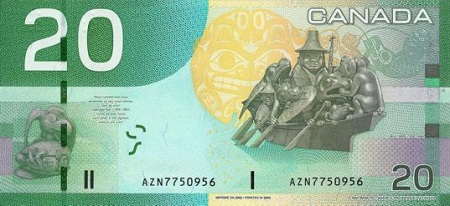CANADA
Canadian Arts

The Canadian 20 dollar banknote is itself a work of art. But it goes an extra step as it celebrates Canadian aboriginal arts and for 20 Dollars, we can all have a few masterpieces of our own on the back of this wonderful banknote.
Since 1954, the Canadian 20 dollar banknote has featured her Majesty Queen Elizabeth II on the front, who is the reigning monarchy. She took the throne in April 1952 after her fathers death, and in June of the same year at Westminster Abbey, she was proclaimed Queen of the United Kingdom and its commonwealth, which includes Canada. The reverse of the note is dedicated to the arts. There are five art related objects on the reverse which celebrate the Canadian aboriginal arts, and art in general.
There is the quote from Gabrielle Roy’s novel, The Hidden Treasure which reads in French and in English: “Could we ever know each other in the slightest without the arts?” Gabrielle Roy was the author of many books including The Tin Flute, Street of Riches, Enchanted Summer and Alexandre Chenevert.
The remaining four images are native artwork done by the famed Canadian artist Bill Reid. Though he struggled with Parkinson’s disease throughout his artistic career, Bill Reid became Canada’s most accomplished artist, and was the recipient of many national and international awards. He died in 1998 from his long fight with Parkinson’s disease. His work in the indigenous Haida style was chosen to represent the Canadian Aboriginal artwork on the 20 dollar note. The illustrations for the note were done by the Canadian Banknote Company artist Jorge Peral.
His artwork includes the Raven and the First Men sculpture, which is reproduced on the left side of the banknote. The Raven has long been understood by the Haida Clan to have a creative, helping spirit, who will go to great lengths to help others. His tricks are tools that help others to learn. He was known to change shape and bring changes to mankind. It is further known that the Raven is one of the most intelligent animals and has the second broadest vocal range, right after humans. This may help to explain the Haida’s reverence for the Raven, which is expressed in legend about the Raven and the First Men handed from Haida Culture. The legend purports that the Raven was alone on the Rose Spit in the Queen Charlotte Islands when he spied a clamshell. The Raven’s curious nature drew him closer and he saw that there were very small human beings that were living in the shell. The beneficent Raven was charmed by these creatures and invited the small humans to come away with him to his land where he would help them. These were the first Haida peoples.
The next illustration is found in the center right background of the banknote and is the Haida Grizzly Bear. According to legend, the Grizzly Bears didn’t always have humps on their backs, and long ago, they were living near the black bears in the forest, and the Grizzly Bears were out of food. They decided to steal food from the cave of the black bears and set out to find it. When they arrived, they plundered the food and ate all they could eat: berries, honey, and everything else. Their belly’s full, they left the cave and headed to their home. But when they arrived, the Ruler of the Forest was there to great them. The grizzly bears were frightened, for they were full of guilt. When the Ruler of the Forest accused them of stealing the food from the black bear’s cave, the grizzlies thought quick and blamed it on greedy nature of the black bears. After all, how could the Ruler of the Forest tell for certain? The Ruler of the Forest thought and said “Then from now on you shall have humps on your backs, and I will be able to tell who is stealing the food.” The Grizzlies never stole from the black bears again, but they still have humps on their backs from that day long ago.
The third image of artwork is the Mythic Messengers shown on the far right. This original work by Bill Reid told the story of how power was transmitted between the mythological animals and peoples. The banknote unfortunately shows only a glimpse of the whole piece of artwork but it is enough to evoke the importance of oral traditions.
The last work of art shown on the banknote is most prominent and is shown center right. It is the Spirit of the Haida Gwaii. In his most famous piece of artwork, Bill Reid depicts the Grizzly Bear and his human wife with their cubs, Mouse Woman (who helps youngsters in need), both the Good and Bad Bears, Beaver, Eagle, Frog, Wolf, Dogfish Woman (who was carried off by a dogfish, and became one of them – but can change back to human form), a small Human paddler, and the Shaman dressed in traditional Haida garments. These creatures are all in a single canoe, being paddled by the small human and the Raven. The symbology is that while these creatures may not all get along they are nonetheless working together and going forward for their collective good.

